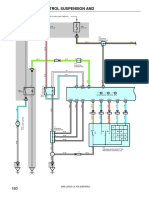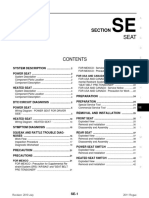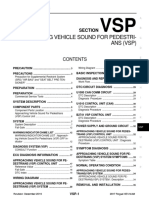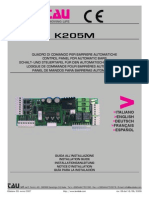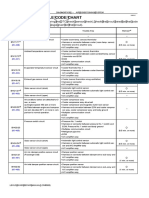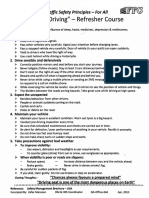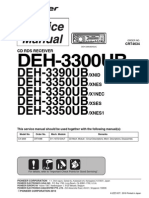GX 470+ride+height
GX 470+ride+height
Uploaded by
Timothy MartinCopyright:
Available Formats
GX 470+ride+height
GX 470+ride+height
Uploaded by
Timothy MartinOriginal Title
Copyright
Available Formats
Share this document
Did you find this document useful?
Is this content inappropriate?
Copyright:
Available Formats
GX 470+ride+height
GX 470+ride+height
Uploaded by
Timothy MartinCopyright:
Available Formats
05−613
DIAGNOSTICS − TEMS & REAR AIR SUSPENSION SYSTEM 05AFA−01
DTC C1733/33 GATE SOLENOID VALVE CIRCUIT
DTC C1734/34 LEVELING SOLENOID VALVE CIRCUIT
DTC C1735/35 EXHAUST SOLENOID VALVE CIRCUIT
DTC C1744/44 TANK SOLENOID VALVE CIRCUIT
CIRCUIT DESCRIPTION
The suspension control ECU opens the height control valve to lead the compressed air to the pneumatic
cylinder and raise the vehicle height.
When the vehicle height is lowered, the suspension control ECU opens the height control valve to store the
compressed air in the low pressure tank temporarily, and then operates the exhaust solenoid valve to release
the compressed air to the outside.
Further, the height control solenoid valve (gate solenoid valve) opens and closes the passage between the
right and left pneumatic cylinder.
The height control valve is on the low pressure tank and consists of 3 valves in total, leveling solenoid valve,
gate solenoid valve and tank solenoid valve.
The leveling solenoid valve opens and close the passage between the compressor and the pneumatic cylin-
der. The gate solenoid valve opens and close the passage between the right and left pneumatic cylinder.
The tank solenoid valve opens and closes the passage between pneumatic cylinder and the low pressure
tank. The exhaust solenoid valve is on the compressor unit and has only one valve.
DTC No. DTC Detecting Condition Trouble Area
S Gate solenoid valve
C1733/33 S Gate solenoid valve circuit
S Suspension control ECU
Either the condition 1 or 2. is detected:
S Leveling solenoid valve
1. With the height control solenoid valve (or exhaust solenoid
C1734/34 S Leveling solenoid valve circuit
valve) inactivated, an open signal of the height control sole- S Suspension control ECU
noid
id valve
l isi detected
d t t d for
f 1 sec. or more.
S Exhaust solenoid valve
2. With the height control solenoid valve (or exhaust solenoid
C1735/35 S Exhaust solenoid valve circuit
valve) activated, a short signal of the valve is detected 8
S Suspension control ECU
times successively.
successively
S Tank solenoid valve
C1744/44 S Tank solenoid valve circuit
S Suspension control ECU
HINT:
S Once ECU stores DTC C1733/33, C1734/34, C1735/35 or C1744/44 in the memory, the vehicle height
control is not carried out until a normal signal is input to ECU from the height control solenoid valves
and the exhaust solenoid valve. However, the control is resumed if the ignition switch is turned OFF,
then ON again.
S Malfunction in the gate solenoid valve and the leveling solenoid valve:
The height control operation is suspended, and the height control indicator lamp dose not change by
operating the height control switch.
LAND CRUISER PRADO REPAIR MANUAL (RM990E)
05−614
DIAGNOSTICS − TEMS & REAR AIR SUSPENSION SYSTEM
S Malfunction in the exhaust solenoid valve:
The vehicle height is lowered to the normal height within 30 sec., and then the height control operation
is suspended. The height control indicator lamp ”N” comes on or blinks, and that of ”HI” and ”LO” do
not come on by operating the height control switch ”UP” and ”DOWN”.
S Abnormality of the tank solenoid valve:
Although the height control is still possible, the lowering speed may be slower.
WIRING DIAGRAM
Suspension Control ECU
L5
Tank Solenoid Valve 12 7
W−B P−G P−G
BC2 S19 SLLO
1 2
R29
Gate Solenoid 14 1
V−W V−W
Valve and Leveling LH+ 1 BC2 S19 SLRL
Solenoid Valve
13 2
W−B V V
E RH+ BC2 S19 SLRR
2 3
H15
Exhaust Solenoid Valve 15 8
W−B LG LG
BC2 S19 SLEX
2 1
W−B
BQ
F43258
LAND CRUISER PRADO REPAIR MANUAL (RM990E)
05−615
DIAGNOSTICS − TEMS & REAR AIR SUSPENSION SYSTEM
INSPECTION PROCEDURE
HINT:
S Proceed to troubleshooting following the flow chart, regardless of whether or not DTC C1733/33,
C1734/34, C1735/35 or C1744/44 is displayed.
S If DTC C1761/61 (ECU malfunction) and/or C1774/74 (power source circuit) is displayed, perform the
inspection necessary for DTC C1761/61 (See page 05−630) and/or C1774/74 (See page 05−632)
first.
(If DTC C1761/61 the and C1774/74 are output at the same time, perform the inspection necessary
for DTC C1774/74 first.)
S Start the inspection from step 1 the in case of using the hand−held tester, and start from step 2 in the
case of not using the hand−held tester.
S Since the exhaust solenoid valve cannot be tested in ACTIVE TEST, start the inspection from step 2.
1 PERFORM ACTIVE TEST BY HAND−HELD TESTER
(a) Connect the hand−held tester to DLC3.
(b) Turn the ignition switch to ON, and turn the hand−held tester main switch to ON.
(c) Select the item ”LEVEL SOL REAR”, ”GATE SOL REAR”, ”LOW PRS TNK SOL” in the ACTIVE TEST,
and operate it with the hand−held tester.
(d) Check whether the solenoid makes sound.
(e) Check whether the height control solenoid valve has a continuity (having vibration).
Standard:
The solenoid makes sound, and the height control solenoid valve has a continuity (having
vibration).
OK CHECK AND REPLACE SUSPENSION
CONTROL ECU (See page 01−36)
NG
LAND CRUISER PRADO REPAIR MANUAL (RM990E)
05−616
DIAGNOSTICS − TEMS & REAR AIR SUSPENSION SYSTEM
2 INSPECT HEIGHT CONTROL SOLENOID VALVE OR EXHAUST SOLENOID VALVE
(a) Disconnect the valve connector.
Gate Solenoid Valve:
Leveling Solenoid Valve: (b) Measure resistance between terminals.
Standard:
Solenoid valve Tester connection Resistance
Gate solenoid valve 1−2 17.5 − 21.5 W
3 Leveling solenoid valve 2−3 10 − 14 W
1 Exhaust solenoid valve 1−2 10 − 14 W
2
Tank solenoid valve 1−2 10 − 14 W
Exhaust Solenoid Valve: HINT:
Tank Solenoid Valve: The height control solenoid valve has 2 connectors.
S The gate solenoid valve and the leveling solenoid valve
have a 3−pole connector.
2 1 S Tank solenoid valve connector has a 2−pole connector.
(c) Check the operating sound of the valves when battery
positive voltage is applied to the terminals as shown be-
low.
Solenoid valve Battery positive Battery negative
Gate Solenoid Valve:
Gate solenoid valve 1 2
Leveling Solenoid Valve:
Leveling solenoid valve 3 2
Exhaust solenoid valve 1 2
(+)
Tank solenoid valve 2 1
3 Standard:
1 (−) It make an operating sound (click).
2
HINT:
Exhaust Solenoid Valve: S When a malfunction is found on the gate solenoid valve,
Tank Solenoid Valve:
the leveling valve or the tank solenoid valve, replace the
height control reservoir assy.
2 1
S When a malfunction is found on the exhaust solenoid
valve, replace the height control dryer assy.
(−) (+)
F43245
NG REPLACE HEIGHT CONTROL RESERVOIR
ASSY
NG REPLACE HEIGHT CONTROL DRYER ASSY
OK
LAND CRUISER PRADO REPAIR MANUAL (RM990E)
05−617
DIAGNOSTICS − TEMS & REAR AIR SUSPENSION SYSTEM
3 CHECK HARNESS AND CONNECTOR(HEIGHT CONTROL SOLENOID VALVE OR
EXHAUST SOLENOID VALVE − SUSPENSION CONTROL ECU)
(a) Check for open and short circuit in the harness and the connector between the height control solenoid
valve or the exhaust solenoid valve and the suspension control ECU (See page 01−36).
NG REPAIR OR REPLACE HARNESS OR
CONNECTOR
OK
CHECK AND REPLACE SUSPENSION CONTROL ECU (See page 01−36)
LAND CRUISER PRADO REPAIR MANUAL (RM990E)
You might also like
- 2017 G 3.3 T-GDI Schematic Diagrams Engine Electrical System Engine Control System Schematic DiagramsDocument1 page2017 G 3.3 T-GDI Schematic Diagrams Engine Electrical System Engine Control System Schematic DiagramsRomulo AfanNo ratings yet
- Abbreviations Used in Honda ManualDocument5 pagesAbbreviations Used in Honda ManualLazarus GutaNo ratings yet
- Evaporator Temperature Sensor DiagnoseDocument2 pagesEvaporator Temperature Sensor DiagnoseJohn DareNo ratings yet
- VEH-MB-ML320-W163 Climate Control (2002-05) Part1 PDFDocument6 pagesVEH-MB-ML320-W163 Climate Control (2002-05) Part1 PDFd9dNo ratings yet
- 1 ShutoffDocument4 pages1 ShutoffAnonymous b5JnNaf100% (1)
- Shogun 2001 Fuel ProblemDocument6 pagesShogun 2001 Fuel ProblemJose GilmerNo ratings yet
- NPR 400 AmtDocument3 pagesNPR 400 AmtHermanNo ratings yet
- Электрическая Схема AhcDocument7 pagesЭлектрическая Схема AhcTimothy MartinNo ratings yet
- Электрические схемы 2005 год LRL 21 38 53 501Document249 pagesЭлектрические схемы 2005 год LRL 21 38 53 501Dmitrii Panasiuk100% (1)
- GM - Coduri EroareDocument2 pagesGM - Coduri Eroarecostel_800% (1)
- Section 1F: Daewoo J100 Bl2 / Bl3Document347 pagesSection 1F: Daewoo J100 Bl2 / Bl3Jarry PotterNo ratings yet
- Manual - 1ME09 - Rev1 TOMTOMDocument13 pagesManual - 1ME09 - Rev1 TOMTOMCarlos GuerconNo ratings yet
- Power Supply, Ground & Circuit Elements: SectionDocument75 pagesPower Supply, Ground & Circuit Elements: SectionemenelikNo ratings yet
- 2005 Nissan Pathfinder 191 200Document10 pages2005 Nissan Pathfinder 191 200lobitoferoz81No ratings yet
- SM1800 GBDocument4 pagesSM1800 GBAristides AnselmoNo ratings yet
- Toyota Tundra - New Features 172: Air Injection SystemDocument5 pagesToyota Tundra - New Features 172: Air Injection SystemPansho TorresNo ratings yet
- MVB 56 Manual PDFDocument4 pagesMVB 56 Manual PDFdwNo ratings yet
- BYD L3-Owner's Manual 2011-6-15-EN PDFDocument216 pagesBYD L3-Owner's Manual 2011-6-15-EN PDFmarcoidone100% (1)
- Grand Am Continental Tire Sports Integrating ECU PDFDocument31 pagesGrand Am Continental Tire Sports Integrating ECU PDFsenthilvlNo ratings yet
- 2011 Nissan Rogue 49895Document43 pages2011 Nissan Rogue 49895EduRoiNo ratings yet
- Mazda 3 OBD Codes: EngineDocument13 pagesMazda 3 OBD Codes: EnginecpureaperNo ratings yet
- DVB - Nl5101d Set Top BoxDocument5 pagesDVB - Nl5101d Set Top BoxSrinivasa Raju KNo ratings yet
- 2011 GM Vehicle Diagnostic Report - 2g4gr5ec3b9179868 - 2023027130232Document3 pages2011 GM Vehicle Diagnostic Report - 2g4gr5ec3b9179868 - 2023027130232eduardo maciasNo ratings yet
- Biante SKYACTIV: Dimension & Weight Seating & TrimDocument4 pagesBiante SKYACTIV: Dimension & Weight Seating & Trimyusransyah100% (1)
- GEELYDocument13 pagesGEELYАнатолий Андрианов100% (1)
- DTC B1135/24 Harf Connection in Airbag Sensor Assy ConnectorDocument2 pagesDTC B1135/24 Harf Connection in Airbag Sensor Assy ConnectorPhang KumwingNo ratings yet
- Approaching Vehicle Sound For Pedestri-Ans (VSP) : SectionDocument37 pagesApproaching Vehicle Sound For Pedestri-Ans (VSP) : SectionA_triniNo ratings yet
- Tau k205m Boomgate ManualDocument11 pagesTau k205m Boomgate ManualPenta GuardNo ratings yet
- Engine Control System (QR25 Engine For Mexico)Document16 pagesEngine Control System (QR25 Engine For Mexico)rafamackintoshNo ratings yet
- Ob D Fault CodesDocument142 pagesOb D Fault CodesAnonymous GmbdAQGhNo ratings yet
- Codigos de Falla NissanDocument2 pagesCodigos de Falla NissanJorge Antonio GuillenNo ratings yet
- SM 11Document128 pagesSM 11jaciel leonNo ratings yet
- Hqew Tle5216Document17 pagesHqew Tle5216Olga PlohotnichenkoNo ratings yet
- Menciones de FuntoroDocument16 pagesMenciones de FuntoroMark MonzonNo ratings yet
- Diagnostic Trouble Code Chart: Sae ControlledDocument4 pagesDiagnostic Trouble Code Chart: Sae ControlledShameer KhanNo ratings yet
- AC Trouble CodesDocument2 pagesAC Trouble CodesYasir SalehNo ratings yet
- RRS Suspension PDFDocument38 pagesRRS Suspension PDFHumberto Cadori FilhoNo ratings yet
- How To Proceed With TroubleshootingDocument9 pagesHow To Proceed With TroubleshootingdiemnganNo ratings yet
- DTC Table (PJB)Document2 pagesDTC Table (PJB)Candace Frank100% (1)
- GW Motor MR20DEDocument74 pagesGW Motor MR20DEGamaliel Urbina JacNo ratings yet
- Service Manual Acer Aspire 9300 7000 Acer Travel Mate 7510Document136 pagesService Manual Acer Aspire 9300 7000 Acer Travel Mate 7510Soporte Tecnico Buenos AiresNo ratings yet
- Engine Assembly PulldownDocument22 pagesEngine Assembly PulldownDwight SolinaNo ratings yet
- CP9145 User Manual PDFDocument90 pagesCP9145 User Manual PDFJorge OsorioNo ratings yet
- List of Diagnostic Trouble Code (DTC)Document5 pagesList of Diagnostic Trouble Code (DTC)Dev Vrat Bohra0% (1)
- Ta Kmsw500Document24 pagesTa Kmsw500Orangzeb Khan0% (1)
- 2GR FE ChargingDocument25 pages2GR FE Chargingmink4uNo ratings yet
- Data Sheet Nissan NavaraDocument1 pageData Sheet Nissan NavaraSebastián Valencia100% (1)
- Manual User Alarm Prestige APS787Z - OMDocument16 pagesManual User Alarm Prestige APS787Z - OMRogerNo ratings yet
- Diagnostic Trouble Code ChartDocument5 pagesDiagnostic Trouble Code ChartGregory AshleyNo ratings yet
- Terms: Abbreviations Used in ManualDocument6 pagesTerms: Abbreviations Used in ManualKevin StrongNo ratings yet
- Idle Air Control Systems: Section 6Document20 pagesIdle Air Control Systems: Section 6sungjoo75No ratings yet
- Anti-Skid Braking System (ABS) : Group 35BDocument82 pagesAnti-Skid Braking System (ABS) : Group 35BРинатNo ratings yet
- SMV Operation Manual For GeneralPCDocument14 pagesSMV Operation Manual For GeneralPCMecanica Automotriz Tecnificada INo ratings yet
- 2015 Nissan 370Z 3.7L Eng VIN A TouringDocument69 pages2015 Nissan 370Z 3.7L Eng VIN A TouringData TécnicaNo ratings yet
- T o y o T A Avensis 2003. 2009 Theft Deterrent & Door Lock PDFDocument35 pagesT o y o T A Avensis 2003. 2009 Theft Deterrent & Door Lock PDFEladio NahuelhualNo ratings yet
- Toyota Generic OBD1 CodesDocument1 pageToyota Generic OBD1 Codesjona9509No ratings yet
- Maintenance Manual of Chery Karry - Circuit DiagramDocument16 pagesMaintenance Manual of Chery Karry - Circuit DiagramUmar ShamsudinNo ratings yet
- P0773Document5 pagesP0773Noel Alejandro Cordova RangelNo ratings yet
- C1735 PDFDocument3 pagesC1735 PDFbob loblawNo ratings yet
- DTC C1751/51 Continuous Electric Current To Height Control CompressorDocument3 pagesDTC C1751/51 Continuous Electric Current To Height Control CompressorBogdan SeciuNo ratings yet
- Reference Guide To Useful Electronic Circuits And Circuit Design Techniques - Part 2From EverandReference Guide To Useful Electronic Circuits And Circuit Design Techniques - Part 2No ratings yet
- Проверка Клизмы - Метод 7 ДеленийDocument1 pageПроверка Клизмы - Метод 7 ДеленийTimothy MartinNo ratings yet
- 6 B 15 e 9 BeDocument20 pages6 B 15 e 9 BeWhiro Opo AriefNo ratings yet
- AHC Suspention FluidDocument1 pageAHC Suspention FluidTimothy MartinNo ratings yet
- K20 Engine Control Module X1Document4 pagesK20 Engine Control Module X1Data TécnicaNo ratings yet
- Introduction To Session BeansDocument36 pagesIntroduction To Session BeansAman Destiny UnfoldedNo ratings yet
- PS21245 eDocument9 pagesPS21245 eTol SirtNo ratings yet
- A Spark Erosion Apparatus - MikesworkshopDocument15 pagesA Spark Erosion Apparatus - MikesworkshopjrnelsonNo ratings yet
- Pump SelectionDocument7 pagesPump SelectionSakir ZakNo ratings yet
- ResumeDocument3 pagesResumeswapnillohaniNo ratings yet
- Module For OshDocument2 pagesModule For OshHassahDah SeRolfalliv LaDivNo ratings yet
- 2012 Catalog FullDocument404 pages2012 Catalog FullgolesfredyNo ratings yet
- Union Special 57700L and N (01-12)Document12 pagesUnion Special 57700L and N (01-12)antonio ramosNo ratings yet
- Excerpts Taken From Asme Boiler and Pressure Vessel CodeDocument3 pagesExcerpts Taken From Asme Boiler and Pressure Vessel Codeஅன்புடன் அஸ்வின்No ratings yet
- RRR 8 DDocument401 pagesRRR 8 DRafi UdeenNo ratings yet
- RTU-485 Manual enDocument14 pagesRTU-485 Manual enjrobertoamaralNo ratings yet
- 365a TieriiiDocument2 pages365a TieriiiAkhmad SebehNo ratings yet
- Test Lamp W867CDocument1 pageTest Lamp W867CDiana de la RosaNo ratings yet
- Flyer-42nd National Convention PDFDocument2 pagesFlyer-42nd National Convention PDFErnesto Marimla Jr.No ratings yet
- Training Report of Nutech PhotolithographersDocument33 pagesTraining Report of Nutech PhotolithographersKuldeep AggarwalNo ratings yet
- DIP Lec1Document61 pagesDIP Lec1Armughan AhmadNo ratings yet
- Software Requirements Specification For: COMSATS University Islamabad, Park Road, Chak Shahzad, Islamabad PakistanDocument44 pagesSoftware Requirements Specification For: COMSATS University Islamabad, Park Road, Chak Shahzad, Islamabad PakistanaddiNo ratings yet
- Third Quiz - Second Semester 2019-2020: Roberto I. Canda University of Southeastern PhilippinesDocument2 pagesThird Quiz - Second Semester 2019-2020: Roberto I. Canda University of Southeastern PhilippinesJordan-James OlivoNo ratings yet
- Ahg Gas Oxygen Backup System Project: Backup System UpgradeDocument1 pageAhg Gas Oxygen Backup System Project: Backup System UpgradeAhmedNo ratings yet
- Light: 1 Electromagnetic Spectrum and Visible LightDocument11 pagesLight: 1 Electromagnetic Spectrum and Visible LightAyushJaiswalNo ratings yet
- Unit 1... Optical PDFDocument38 pagesUnit 1... Optical PDFSurudhi AsokrajNo ratings yet
- GT 11. Modul Operating ProcedureDocument19 pagesGT 11. Modul Operating Procedurepraztt69No ratings yet
- Data Sheet G08101374 Dussan PDFDocument2 pagesData Sheet G08101374 Dussan PDFWilliam AlvaradoNo ratings yet
- CarsonDocument5 pagesCarsonMarko IstenicNo ratings yet
- Prod 19440923712Document7 pagesProd 19440923712Saman SafdarNo ratings yet
- Examination Report - SH DamDocument59 pagesExamination Report - SH DamsarvannnNo ratings yet
- Safe Driving - TipsDocument1 pageSafe Driving - TipsZain ZulfiqarNo ratings yet
- 6493 1002 9838 3350 (BULK ORDERS) Tiny - CC/DCT - FB @dynacore: 81330458 (WhatsappDocument10 pages6493 1002 9838 3350 (BULK ORDERS) Tiny - CC/DCT - FB @dynacore: 81330458 (WhatsappChee JianzhiNo ratings yet
- Pioneer Deh-3300 3350 3390ubDocument64 pagesPioneer Deh-3300 3350 3390ubjmbernal7487886No ratings yet







